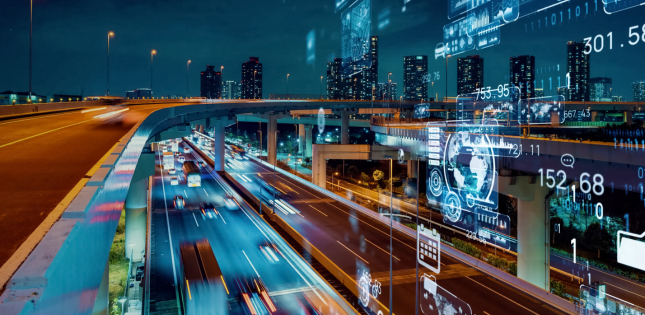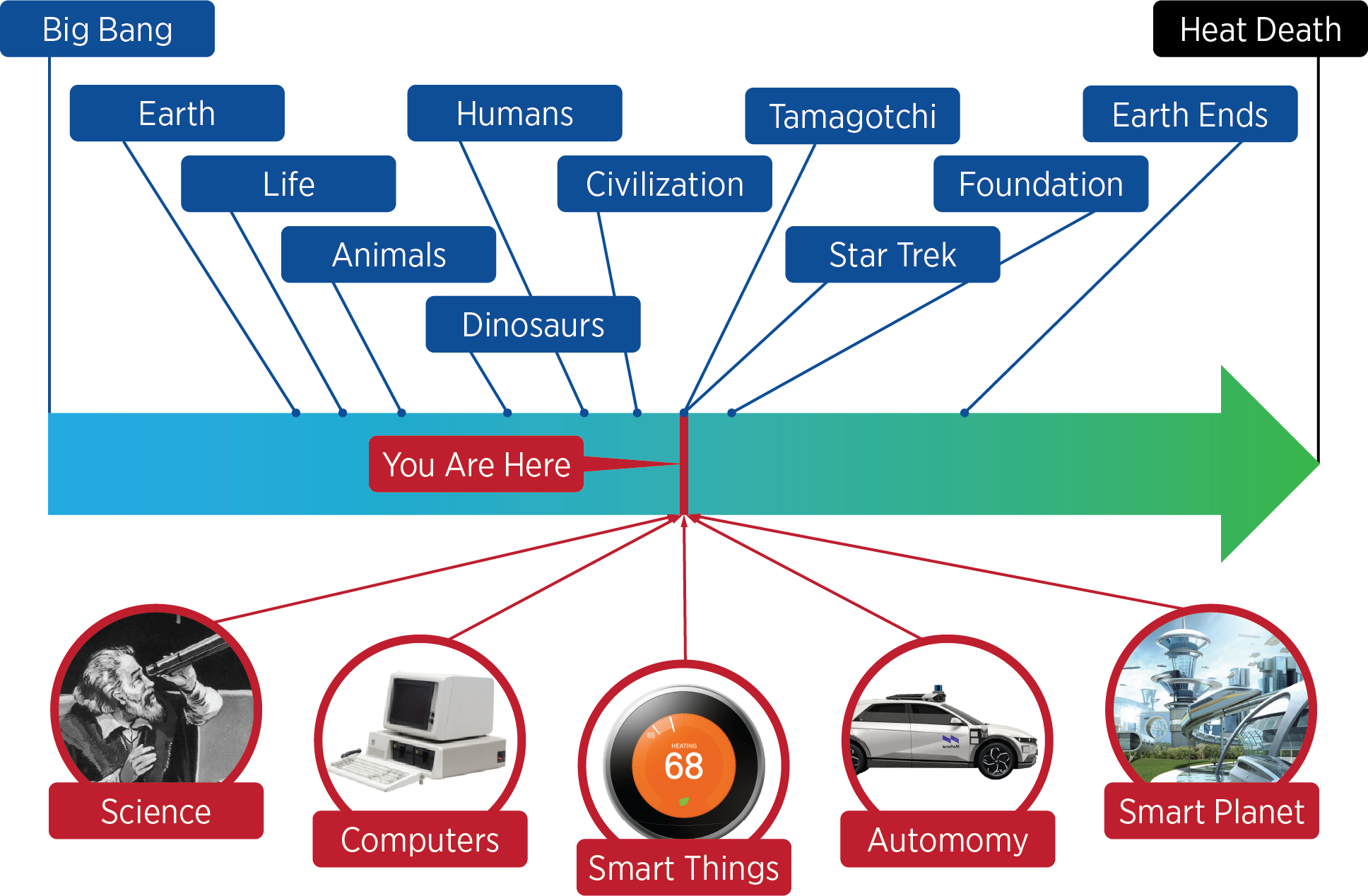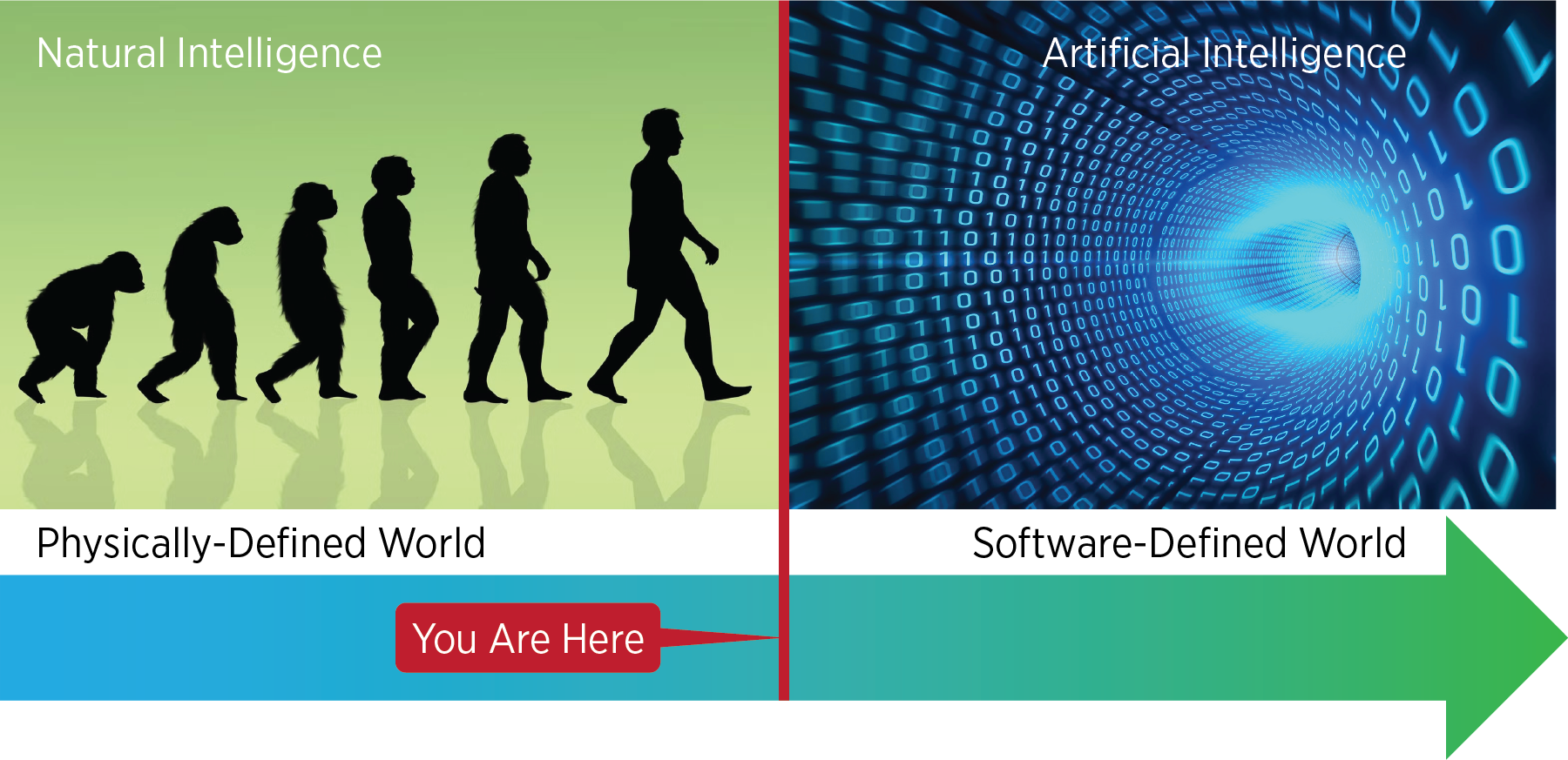
“In the near future, AI will play a dominant role in managing and running everyday infrastructure, from transportation systems to power grids, making decisions and carrying out tasks with unprecedented speed and efficiency.”
– Chat GPT
This is the first time I’ve quoted an artificial intelligence (AI) in writing. It will not be my last, nor yours. That’s because we live in what is perhaps the most profound transition in history. For the first time in history, there’s a fundamentally new source of intelligence. And that intelligence is growing, quickly. Nothing will ever again be the same.
It may seem extreme to call this one of history’s most profound transitions. But let’s look at the truly profound transitions in the biggest possible picture:

The Really Big Picture. The universe is about 14 billion years old. If we speculate that it will last another 14 billion years, it includes the origin and end of everything we know, all the creatures, civilization, science, and even all the science fiction. Of course, many transitions have and will happen in that time. But there is clearly something very new starting right now: technology. The most striking thing is how early we are in technology evolution. If the arrow above were drawn to scale, the red line—a 750-year transition from the dawn of science to the era of Star Trek—would be only a few atoms thick. Our moment is special.
That tiny red line includes the first science, computers, smart things, autonomy, and a truly smart planet. The Tamagotchi, a simple electronic “pet” that required care to stay “alive”, may seem out of place. But when it was introduced 25 years ago, it was the first “intelligent” device to appear across the planet. It’s the electronic equivalent of the first one-celled life, released into the wild as a Smart Thing.
So why is this so profound? Like a new life form, artificial intelligence is evolving to compete with natural intelligence. It truly is a pivotal moment. After that red line, nothing will be the same.

The Red Line. Before the red line, intelligence arose only as natural selection strove to preserve and propagate genes. After, AI is a new source of increasing intelligence.
AI can and will run cars, traffic control, urban air mobility, trains, renewable energy, hospital devices, surgical robots, naval systems, air defense, avionics, simulation and training. It will make the entire planet run better. But it’s not that simple. Today’s AI systems like ChatGPT run in the cloud. And cloud AI by itself can’t change the way the world actually runs.
To work in the real world, AI needs a connection to the sensors and actuators (motors) that let it sense and act on things. And the connection must be reliable enough to trust, fast enough to act, scalable enough to handle huge distributed infrastructure, and conceptually clean enough to organize thousands or millions of components. Intelligent real-world systems need to interface a lot of software in ways that are fundamentally different from all the other software systems on the planet. It’s a really (really) hard problem and essentially the subject of this blog series:
How can we enable the intelligence of our future to control the physical world of our past?
The answer, somewhat surprisingly, is not about the algorithms or processors. The key to progress, the realization that makes all these smart systems practical, is the importance of data. And the most important difference between cloud systems and real world systems is how the AIs get that data.
But before we get to that, let’s take a peek at the potential…
A Look at the Future
Let’s look at a potential future about 25 years from now. By then, Moore’s law predicts that chips will be 100,000x more capable than today. So even mobile chips will be capable of a sustained 1.0 exaFLOPs. That power will transform the planet…
Flying drones and transports dot the skies, surprisingly silent. Wheeled bags follow their owners down the sidewalk. eScooters, both with and without passengers, seamlessly merge into the mix. Larger transports, ranging from single-person pods to full-size buses, ply the roadways. Passengers are riders, not drivers. The few humans in control of these fleets serve functions other than driving, from helping people on and off to making decisions about where to go. There’s no traffic, no waiting, no honking, and no parking lots.
There are also fewer safety worries. As a former automotive safety researcher, I humbly submit that safety is not autonomy’s biggest challenge. The bar for autonomy should be only to exceed the distressing safety record of humans. The crossover point in many environments is not that high. Autonomy will eventually prove safer—much safer—than human drivers. Like a dangerous teenage driver, autonomy will mature, too. It just takes a few decades of experience.
In hospitals, the staff interacts with patients and discusses treatments rather than running from room to room and documenting every action. Technology is now an indispensable part of the care team. Only a few years ago, staff visits were needed to ensure device operation, interpret readings and warning signs, and ensure constant monitoring. Even in intensive care, patients were only really checked every hour or so. In this future, machines monitor every patient 24x7, and integrate through AIs to improve alarms and recommend treatments. The biggest concerns of the past, like noticing patient deterioration, drug dosage changes, shift fatigue, and simple-but-dangerous mistakes, are gone. The machines handle the normal flow and recognize what’s not normal. The staff can now devote all their attention to critical clinical decisions and personalized care.
In the operating room, almost all surgeries are done with robotics. Robots come in all sorts of shapes: flexible tubes, snake-like arms, octopus-like grippers. Rather than mimicking human hands, they adapt to fit into the nooks and crannies of patients with almost no incisions. They’re guided by ever-more-precise and intelligent images and scans. Remote teams help surgeons learn and collaborate on hard procedures.
New medical technology reduces staffing load and frustration, helps doctors collaborate, and makes better healthcare more accessible and affordable. Because AIs are much more practical to distribute than highly-trained physicians, the entire planet has better care.
In the defense world, despite the obvious opportunity for increased lethality, technology can lower the chances of war. Intelligent distributed networks intimately connect sensors, shooters, and decision makers. The resulting full information systems are far more understandable—this eliminates much of the “fog of war” and helps calm international nerves. Global-scale realistic simulation makes training far better, lessening the risk of poor decisions. Even terrorism worries are lessened by long-dwell-time ocean surveillance drones. Bottom line, defensive strength and better information flow discourage conflict. Overall, the world is safer with each passing year.
And what of the environment? Transportation is certainly greener. There are few things with exhaust; EVs are the norm. Urban flight is also electric; advanced prop and thruster design accounts for the silence. Hyperloops speed across distances faster than airplanes with 100% solar energy. Smart vehicles are not just safer and more efficient. They also take pollution out of the air and crowded parking lots out of the city.
The grid is also making much better use of unreliable wind and solar sources. Back in the 2020s, hydropower was already transitioning to a grid balancing function, filling in when renewables went offline and backing off when wind and sun were plentiful. Finally, this design is spreading to more types of generators and utility-scale storage technologies. With distributed control, we are making the dream of green energy viable.
This may seem like science fiction, but it’s not just fiction. All these applications are (projections of) current RTI customer projects. They are early applications on the road to a truly smart planet.
The Key to The Software-Defined Future
Data is what makes AI work: collect the data and learn. This is how “digital twins” and consumer models work. But the view of data as static stuff that can be “collected” isn’t viable in the real world. Today’s cloud-based AIs have days, months, years, or decades to figure out what ads to show us. Cars, planes, hospitals, and power systems have far less time to understand and react to the environment. These systems deal in milliseconds.
So the key to the smart planet is the importance of data. And the most important difference between cloud systems and real world systems is how the AIs get that data. In summary:
Intelligence in the cloud needs data.
Intelligence in the real world needs dataflow.
To make the world run better, don’t design systems around algorithms, devices, or even functions. To make the world run better, design systems around the dataflow. This “data centricity” organizes the flow into intimately-shared information. Data centricity adapts to many industries, transforming them all to be better.
Blog Series Preview
The era of evolving artificial intelligence in the real world is perhaps better called the “software defined” world, because although the explosion of hardware capability enabled it, it is software that increasingly defines where it can be used. And the most important characteristic of that software is how it controls dataflow. Getting the right data to the right place at the right time enables edge intelligence.
This blog series sets out to examine a key question: How can we enable the intelligence of our future to control the physical world of our past? We will look deeply into the potential and reality of the software-defined future. We will analyze when and how to use data-centric design to implement intelligence. We will examine the challenges and benefits of software-defined systems, including autonomy, extensibility, online interactions, new business models, and cost savings. We will look carefully at the implications of the most profound change of all: updating fielded products to enable evolution. And we’ll dig into near-future use cases, including software-defined vehicles, software-defined medical systems, software-defined defense, and software-defined industrial automation. ChatGPT and its cousins will change the way we interact with the Internet and businesses, but it’s “only” a revolution in the online world. Software-defined systems will change the way the real world runs. That, in the end, is far more profound.
A smart world runs better. Real-time intelligence matters.
About the author
 Stan Schneider is CEO of Real-Time Innovations (RTI), the largest software framework provider for smart machine and real-world systems.
Stan Schneider is CEO of Real-Time Innovations (RTI), the largest software framework provider for smart machine and real-world systems.
Stan also serves on the advisory board for IoT Solutions World Congress and the boards of the Teleoperations Consortium and the Autonomous Vehicle Computing Consortium (AVCC). Stan holds a PhD in EE/CS from Stanford University.
Posts by Tag
- Developers/Engineer (180)
- Technology (79)
- Connext Suite (77)
- News & Events (75)
- 2020 (54)
- Aerospace & Defense (53)
- Standards & Consortia (51)
- Automotive (38)
- 2023 (34)
- 2022 (29)
- IIoT (27)
- 2025 (25)
- Leadership (24)
- Healthcare (23)
- 2024 (22)
- Connectivity Technology (21)
- Cybersecurity (20)
- 2021 (18)
- Culture & Careers (15)
- Military Avionics (15)
- FACE (13)
- Connext Pro (10)
- JADC2 (10)
- ROS 2 (10)
- Connext Tools (7)
- Connext Micro (6)
- Databus (6)
- Transportation (5)
- Case + Code (4)
- Connext (4)
- Connext Cert (4)
- Energy Systems (4)
- FACE Technical Standard (4)
- AI (3)
- Oil & Gas (3)
- Research (3)
- Robotics (3)
- Connext Conference (2)
- Edge Computing (2)
- Golden Dome (2)
- MDO (2)
- MS&T (2)
- RTI Labs (2)
- TSN (2)
- ABMS (1)
- C4ISR (1)
- DOD (1)
- ISO 26262 (1)
- L3Harris (1)
- LabView (1)
- MOSA (1)
- MathWorks (1)
- National Instruments (1)
- Simulation (1)
- Tech Talks (1)
- UAM (1)
- Videos (1)
- eVTOL (1)
 Success-Plan Services
Success-Plan Services Stan Schneider
Stan Schneider